
Planning for growth: Fact sheet
Learn about how population and enrolment projections help us plan for the near future.

NSW is experiencing unprecedented population growth and demand for school spaces, particularly in urban areas.
To help meet the challenge of changing demographics, School Infrastructure is considering innovative options to deliver new schools in specific situations where accessing land is difficult.
For example, partnering with other government agencies and the private sector to plan and deliver schools as part of an integrated development could help reduce land costs and allow schools to be a shared community feature of newly established precincts.
This approach aims to encourage innovation in design and construction and increase opportunities to share publicly owned school facilities with the wider community.
Student-centred and personalised learning will continue to be our focus when planning and delivering NSW public schools. We will also continue to look for ways to use taxpayer funds more efficiently and effectively.
School Infrastructure has begun developing alternative models for the procurement and delivery of public schools in areas where residential density will be high and where population growth is on the rise.
We are working with our partners in the NSW Government, as well as local councils and the private sector to include schools in the centre of community masterplans.
A key component of this work is creating strong links between schools and local industry, community groups and councils. Co-location of schools, further education providers and employers will support improved educational outcomes and innovative education pathways.
This model will help us to address rapid demographic changes and the scarcity of available land in urban renewal precincts. There is also potential to achieve greater value for money when compared to traditional major capital works projects in these types of areas.
To enable this new model, we are developing guidelines for the delivery of integrated schools. We want to ensure that schools can effectively deliver the curriculum, with learning outcomes at the forefront of the integrated school model.
These design principles and guidelines will incorporate lessons learned from both in NSW and around the world. They will also be aligned to a range of existing policies and guidelines that help us build great schools.
By applying standardised learning hub layouts to our school designs in integrated developments, we can potentially access a greater range of sites, as private land holdings may become appropriate for schools within a mixed-use development. For example, designing on a standard grid, like we currently do for modern methods of construction, can be easily applied to the design of commercial buildings.
By partnering with the private sector to plan and deliver schools as part of an integrated development, we can realise benefits and efficiencies, and a new school could be operational around the time that the new community is expanding.

Learn about how population and enrolment projections help us plan for the near future.